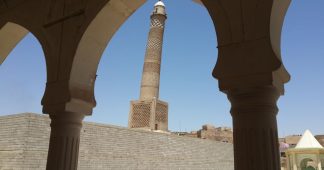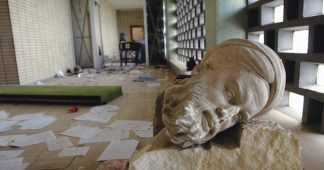By Bill Van Auken
4 September 2018
Brazil’s National Museum in Rio de Janeiro was gutted Sunday night by a massive fire that consumed not only the historic 19th century palace that housed the institution, but a vast and irreplaceable collection of what was by far the largest natural history and anthropology museum in Latin America. The majority of the 20 million items it contained were destroyed.
While the immediate cause of the blaze is still unknown, this catastrophe and the irreparable loss to human culture were the product of policies of austerity and the diversion of vast social resources to feed the profits of international finance capital and a rapacious and culturally backward Brazilian capitalist ruling class.
Starved for resources by the Brazilian government, the museum was a disaster waiting to happen. Firefighters who arrived to fight the blaze were ill-prepared thanks to relentless budget cuts, lacking necessary ladders and other equipment. They found that hydrants near the museum had no water and they were forced to try to pump water from a badly polluted lake nearby.
Museum workers and scientific researchers rushed into the burning building in a desperate attempt to save what little they could. Local residents brought water to the scene and did what they could to help. Many workers, devastated by the scene of destruction, were in tears and embracing each other.
Luiz Duarte, one of the museum’s vice-directors, told TV Globo: “It is an unbearable catastrophe. It is 200 years of this country’s heritage. It is 200 years of memory. It is 200 years of science. It is 200 years of culture, of education.”
Destroyed by the fire was the oldest ancient Egyptian collection anywhere in the Americas, along with Greek artifacts and Roman frescoes that had survived the volcanic destruction of Pompeii.
The blaze also consumed what were the oldest human remains discovered in Latin America, those of “Luzia”, known as “the first Brazilian,” estimated at between 12,500 and 13,000 years old. Likewise destroyed was the 44-foot reconstructed skeleton of a Maxakalisaurus, a plant-eating dinosaur that lived in what is now Brazil 80 million years ago.
The museum also housed a priceless collection of some 100,000 pre-Columbian artifacts from Brazil and elsewhere in the Americas, including Andean mummies, textiles and ceramics.
Also contained in the museum were historic documents chronicling two centuries of Brazilian history. Burned remnants of these priceless papers were found as far as 3 kilometers from the museum after the fire.
The building that housed the museum, the São Cristóvão palace, is one of the most historic structures in Brazil. It became the residence of the royal family of Portugal, which had fled the invasion of Napoleon’s armies for Brazil. It was in the palace that Brazilian independence was declared in 1822, and in which the first Constituent Assembly of the Brazilian Republic convened in 1890, marking the end of the rule of the Portuguese emperor.
Under the management of the Federal University of Rio de Janeiro since 1946, the museum was also a research facility in which Brazilian anthropologists conducted studies that derived from human remains evidence of migration from Polynesia to what is now Brazil. The museum also contained vast collections of flora and fauna specimens, including from extinct species.
The museum was also engaged in training scientists for an expedition to Antarctica to study fossils on the continent.
Professor Paulo Buckup, an expert in fish science at the museum, told the BBC that he was able to rescue a “tiny” part of the museum’s collection of thousands of specimens of mollusks.
“I don’t know how many tens of thousands of insects and crustaceans were lost,” he said. “I feel very sorry for my colleagues, some of whom have worked here for 30 or 40 years. Now all evidence of their work is lost, their lives have lost meaning, too.”
Demonstrators, most of them students from the Federal University of Rio de Janeiro, forced their way onto the site of the destroyed museum on Monday to protest the Brazilian government’s protracted cuts to funding for science and education that found their disastrous expression in the burning down of the museum. Police attacked the students with pepper spray, tear gas and stun grenades.
The burning down of a museum that contained a significant share of the heritage of humanity in the Americas and worldwide was the entirely predictable and preventable outcome of the policies pursued by Brazil’s governments in the face of the onset of the country’s economic crisis in 2014, both under the Workers Party (PT) administration of President Dilma Rousseff and, following her 2016 impeachment on trumped-up charges of budgetary malfeasance, her former right-wing vice president and successor, Michel Temer.
The museum went from receiving a budget of $310,000 in 2013 to just $132,000 in 2014. However, over the last three years it has received 60 percent or less of this amount. The cuts were first imposed under Rousseff’s PT government and then intensified under Temer.
The museum had submitted a report in 2015 saying that it needed 150 million reais (US$36 million) to repair the building, which lacked a sprinkler system and even any basic electrical wiring diagram for the centuries-old structure.
In 2015, the museum was forced to close its doors entirely because it lacked even the funding to pay staff or for minimum service from contractors. The closure had a lasting impact on attendance, which remained at record lows.
The museum marked its bicentenary in June under conditions in which massive budget cuts inflicted by successive governments had left it in a state of advanced decay, with a third of its exhibition halls closed, including some of its most popular, like the one containing the largest dinosaur discovered on Brazilian soil, its base having been eaten away by termites.
In an article on the bicentenary published by Folha de S. Paulo, the reporter noted that “the physical decay of the building that houses the museum … is visible to visitors, who pay 8 reais [less than US$2] for a full-priced ticket. Many of its walls are peeling, there are electrical wires exposed and generalized poor maintenance.”
In the absence of even the most minimal budgetary allocations from the Brazilian government, the museum had launched an internet crowd-funding campaign to raise enough money to reopen its main exhibition hall.
Even as it starved the national museum for funding, the Brazilian government poured millions into structures for the World Cup and the Olympics, which generated lucrative contracts and kickbacks for the ruling PT and other sections of the ruling establishment.
The burning down of Brazil’s national museum and the obliteration of a significant share of the heritage of humanity stands as an indictment of a world capitalist system and a Brazilian national bourgeoisie that subordinates all questions of social policy to the imperative that a handful of individuals continues to accumulate immense riches.
In a country where the wealth of six men is equivalent to that of 50 percent the population, the destruction of culture is an inevitable byproduct of social inequality. Brazil’s super-rich have no interest in anything other than what they can own, pouring their money into helicopters that fly them over the country’s favelas to their offices in Rio and Sao Paulo and into Miami real estate and the global stock markets.
The destruction of the Brazilian National Museum stands as a stark warning to working people in Brazil and throughout the world. The defense of culture, history and the entire legacy of humanity depends upon the building of a mass movement of the international working class directed at putting an end to the irrational, destructive and selfish system of the capitalist ruling class.
Published at http://www.wsws.org/en/articles/2018/09/04/braz-s04.html










